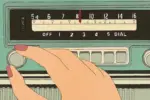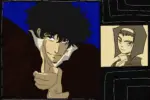After its first season in late 2021, Netflix’s “Cowboy Bebop” was quickly canceled. Now that the dust has settled, it seems like a good time to look back and see why things ended the way they did.
“Cowboy Bebop,” like its namesake, is fast-paced, features adventurous improvisation, and focuses on individual virtuosity. If there is an anime that doubles as the textbook definition of pure perfection, it’s “Cowboy Bebop.” It’s easily the most famous and accessible anime outside of shōnen titles like “Dragon Ball Z,” “Pokémon” and “My Hero Academia.” The show is paced perfectly and hasn’t aged in the slightest — almost 24 years later, it still feels fresh and new.
Netflix’s Relationship with Anime
Netflix’s relationship with anime is a complicated one; on the one hand, there’s all this free exposure, but on the other hand, anything it does with the genre usually sucks (i.e., “Death Note“). So when it was announced that Netflix was making a live-action adaptation of “Cowboy Bebop,” one of the most quintessential anime ever made, many eyebrows were justifiably raised, and the skepticism persisted with each new tease that we got.
It was clear from very early on that Netflix’s “Cowboy Bebop” would need to be very different from the original to work. The dictates of live-action filmmaking restrict how much time its characters can spend in space, for starters, and create challenges for realizing many of the show’s characters.
For instance, Ein has to be a real trained animal capable of the occasionally uncannily human movements of the original. Faye’s original costume would have quickly fallen to pieces in any moderately heavy action scene. And, of course, radical Edward, the gender-ambiguous looney tune tween hacker prodigy, would have to be radically reimagined to work in live-action. Can you imagine a director asking an actor to emulate their character’s performance from an anime? How insanely awkward and cringe would that be? (They did precisely that.)
The Writing
You’ll notice right away that Netflix’s “Cowboy Bebop” tries to be more of a quirky comedy than its source material. Now, “Cowboy Bebop” was not exactly humorless. It could be very amusing at times, but it didn’t wisecrack at every possible opportunity. The live-action series tries a little too hard to go for that kind of meta-humor you get with many Marvel movies nowadays. Characters will sometimes go on complicated rants only to be met with a more grounded statement, or the script gets self-aware as a replacement for actual writing.
You’d think for an adaptation that’s trying to be more comedic, they would give the dialogue a little more flair, but it’s bland. “Cowboy Bebop,” if nothing else, was filled with personality, and there’s just none of that here. It acts as a segue for lousy comedy when the dialogue isn’t wholly flavorless. It desperately tries to capture the spirit and stylishness of the original show. Still, it comes off as a bunch of middle-aged white guys trying to make their dialogue sound cool to capitalize on a genre that has been outperforming them for over a decade.
Trying to make it more mature by giving us more violence, swearing, and gore ironically made the show even more childish. It drags out new character arcs in a show that already feels dragged out since they changed the episode runtime from a comfortable 20 minutes to a full hour. On top of that, the original show was more episodic, with only a few episodes connecting as part of a broader story.
This meant that characters like Vicious and Julia were shrouded in mystery, and it built intrigue and suspense. Here, however, every episode is connected. As a result, Vicious and Julia appear in every episode, cheapening the characters’ mystery and ruining a lot of what made both of them such great characters in the first place. The show lacks the brilliant atmosphere and passion that was abundant in the original.
The Heart and Soul of the Original
Shinichiro Watanabe’s team made a conscious effort to populate the universe of “Cowboy Bebop” with a full spectrum of skin tones, languages, world cultures, sexualities, and even gender identities — an impressive feat considering it was created in 1998. In addition, this breadth of diversity was a focus for Watanabe and the “Cowboy Bebop” team not because it was trendy or marketable, but because they have always considered representation essential.
He was always aiming beyond Japan, at an international audience, with references to everything from “DuckTales” to “Max Headroom” to classic kung fu cinema, and signs in tons of different languages — each end card is written in stylish but also accessibly legible block font English. These global-minded priorities made “Cowboy Bebop” one of the best and most widely beloved anime on Earth.
Twenty-three years later, the live-action version feels slightly less diverse. I’m not talking about the cast and characters’ personalities. I’m talking about their backstories, which seemed rewritten to neutralize every bit of political commentary in the original. In the anime, Jet quit his job as a cop because most of the guys at his precinct were corrupt, either corporate pawns, Syndicate plants, or both — which back in ‘98 was a very explicit critique of the then-current problem of Japanese police colluding with yakuza.
Beyond that, the “Cowboy Bebop” anime doesn’t quite say “all cops are bad” directly. Still, by extension, police and bounty hunters are intensely critical as institutions that serve powerful interests over ordinary people. Even Jet helps the Gate Corporation cover up their culpability in the literal apocalypse to gain some leverage.
In Netflix’s “Cowboy Bebop,” Jet loses his job and wife after being framed for corruption by the one bad-apple Syndicate cop on the whole force. At the end of his special episode, he learns a valuable lesson about how all the other cops, even the one dating his ex-wife, are pretty stand-up guys.
In the anime, Faye’s backstory event that drove her into a life adjacent to crime stems from the inescapable mountain of medical debt she accrued during her 50 years of cryosleep. It was exacerbated by a group of con artists who tricked her into taking on even more debt.
In the live-action show, she is conned by just one cryosleep con-lady who becomes her mom, with no mention of debt. It’s like they surgically removed all implication that privatized medicine might be extortion with extra steps.
There are also multiple episodes where “Cowboy Bebop” references drug use — which, coming out of a country where they patched an actor out of a video game for doing a bit of blow, is one hell of a statement to make. And considering that Netflix reduces “Mushroom Samba” to an item on a diner’s gag menu, it shows how this live-action show doesn’t have the guts to tackle such topics.
“Cowboy Bebop” the anime is a pointedly, unapologetically political work of art that bakes a lot of salient insights about our present into its detailed, dystopian vision of the future. “Cowboy Bebop,” the Netflix live-action show, is a milquetoast, line-toeing, toothless liberal sci-fi action comedy that wants to do some cool shootouts without offending anybody. And that is its single greatest failing as an adaptation.
This drastically differs from the anime, where politics and philosophy — heavy ideas presented in a light, fun, jazzy sci-fi wrapper — are a vital component of its soul. The anime looks forward, not back. I hate the word “woke,” but if we must talk in those terms, Netflix’s “Cowboy Bebop” is demonstrably and substantially less “woke” than the original.
















